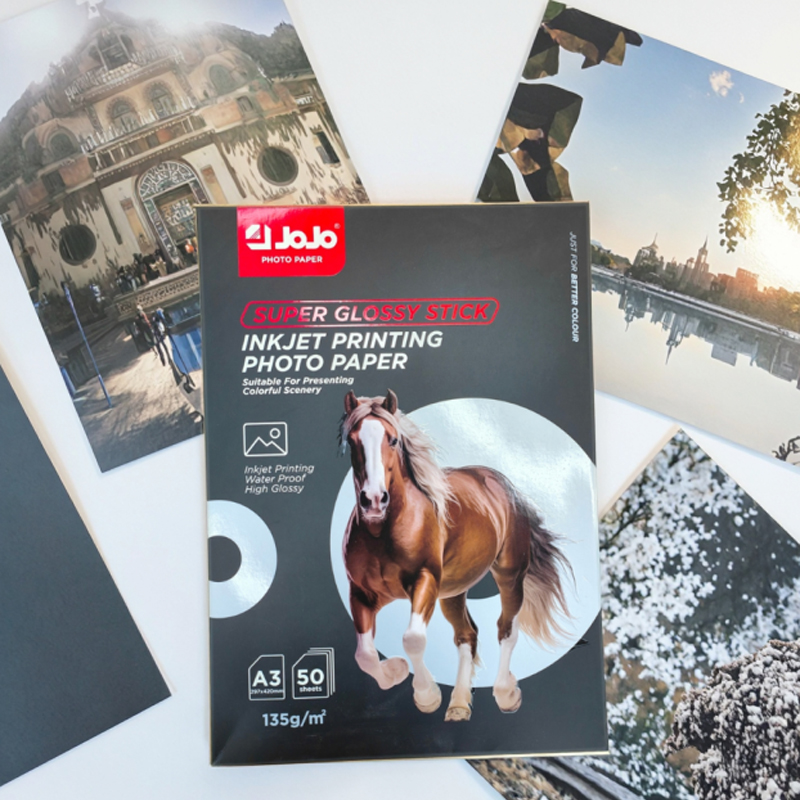If you need any help, please feel free to contact us
Heat Transfer Paper Applications Explained Simply
Heat transfer paper has established itself as a versatile material within the printing industry, particularly among companies specializing in textiles and promotional items. While it is frequently discussed alongside Inkjet Photo Paper and comparable supplies, it occupies a distinct role as a medium that enables printed graphics to be affixed permanently onto a wide range of surfaces. For organizations evaluating Jojo Photo Paper and similar products, gaining a clear understanding of how heat transfer paper functions can assist in aligning material choices with specific production requirements and expectations.

How Heat Transfer Paper Works in Practice
Unlike conventional inkjet photo paper, which is designed to retain ink within the substrate itself, heat transfer paper operates by releasing its printed image onto a separate receiving material through the application of controlled heat and pressure. During production, the design is printed—typically in mirror orientation—on the coated surface of the transfer sheet using an inkjet or laser printer compatible with the selected media.
After preparation, the printed sheet is positioned face-down on the target substrate, which may include cotton textiles, polyester blends, or specially treated rigid surfaces such as ceramics. A heat press is then applied under precise temperature and pressure parameters, activating the adhesive layer embedded within the transfer paper. As a result, the ink or toner bonds with the receiving surface to form a permanent graphic.
This approach has proven especially valuable for applications where flexibility in image content and batch size is necessary, enabling production teams to reproduce photographs, logos, and multicolored illustrations without investing in traditional screen printing infrastructure.
Categories of Heat Transfer Paper
Heat transfer paper is produced in several variations tailored to different substrates and visual objectives. One of the primary distinctions involves light versus dark transfer paper. Light transfer sheets are generally optimized for use on white or pastel fabrics, as they lack an opaque backing layer that would otherwise prevent background colors from influencing the transferred image. By contrast, dark transfer paper incorporates a solid white layer to preserve accurate color reproduction when applied to darker textiles.
In addition, compatibility with the printing equipment requires attention. Some papers are engineered exclusively for inkjet devices, while others are designed for laser printers. Selection of the appropriate category is critical, as incompatibility can result in insufficient adhesion or color shifts. For businesses accustomed to Inkjet Photo Paper, integrating inkjet-compatible transfer sheets often allows a smoother transition, leveraging existing equipment.
Core Steps in Application
Achieving consistent and high-quality transfer results depends on adherence to a carefully structured process. After printing, it is advisable to trim the sheet to remove unprinted margins that may otherwise leave visible film edges on the final product. The prepared transfer is then positioned accurately over the substrate, ensuring alignment with any seams or design guides.
Heat presses are widely recommended due to their capacity to maintain stable temperature and pressure across the entire design area. This uniform application is essential to secure a reliable bond between the printed image and the receiving surface. Although household irons can be used in some circumstances, they often introduce variation in heat distribution, potentially compromising the durability of the transferred design.
Following the heat application phase, the carrier sheet must be removed. Whether a hot peel or cold peel is required depends on the specific formulation of the transfer paper, making it important to follow the manufacturer’s guidance precisely to avoid incomplete adhesion or unintended damage to the transferred image.
Advantages for Small and Medium Production
Heat transfer paper has gained adoption among small businesses, custom print shops, and marketing teams seeking an accessible method for short-run production. Compared to other decoration techniques, it offers flexibility to produce individualized items without the extensive setup processes associated with screen or pad printing.
The capacity to reproduce full-color artwork and photographic content without additional separations is another practical advantage. This feature is especially relevant for organizations aiming to produce visually detailed or gradient-rich designs that would otherwise require specialized equipment.
Common Issues and Preventive Measures
While heat transfer paper provides many benefits, it also presents technical challenges that merit attention. One of the most frequently reported issues involves partial adhesion failures, where sections of the design fail to bond fully to the material. This outcome can result from insufficient pressing temperature, inconsistent pressure, or premature removal of the carrier sheet. To mitigate this risk, operators should confirm that equipment calibration aligns with the transfer paper specifications and perform periodic checks of heat press performance.
Durability during laundering is another consideration, particularly when producing garments intended for regular use. Although transfers are formulated to remain affixed through multiple wash cycles, exposure to high heat and aggressive detergents can accelerate fading or cracking. Advising end users on suitable washing practices, including cooler temperatures and gentle detergents, can help preserve appearance.
Color consistency is also a potential concern. Differences in printer settings, ink formulations, or substrate absorption can influence the final result. Conducting test prints and refining color profiles can improve predictability and reduce production waste.
Selecting the Appropriate Media
Deciding whether to use Inkjet Photo Paper, Jojo Photo Paper, or heat transfer sheets should be based on a clear assessment of the intended application. For displays, framed prints, and portfolios, conventional photo paper remains the standard. Conversely, when the objective is to customize textiles or hard goods, heat transfer paper offers a more suitable approach.
Maintaining clear separation of stocks, labeling packaging accurately, and training personnel to recognize each category can reduce the potential for errors during high-volume periods.
Heat transfer paper represents a practical and adaptable method for producing customized graphics across a variety of materials. By developing a detailed understanding of its properties, preparation requirements, and limitations, print operators can make more informed decisions about integrating this technology into their production workflows.

 English
English Español
Español 中文简体
中文简体 Português
Português

